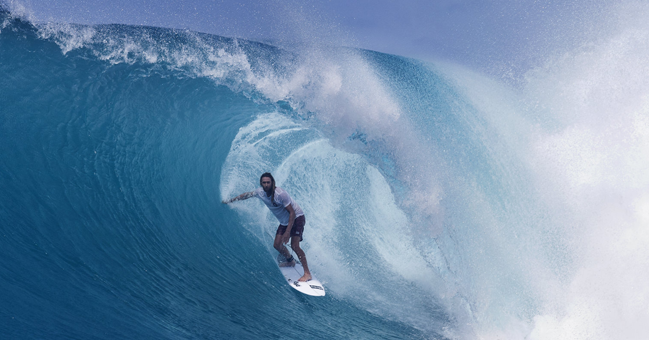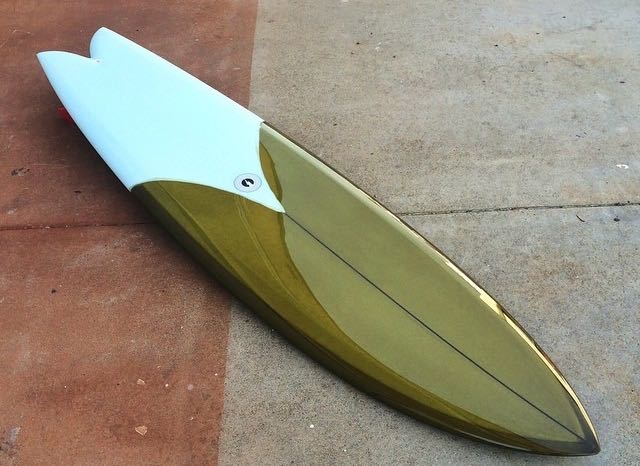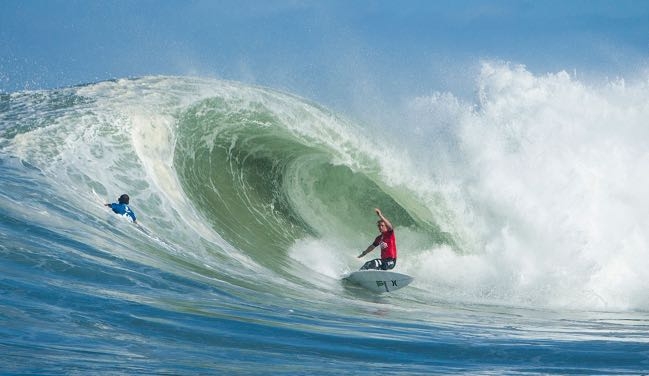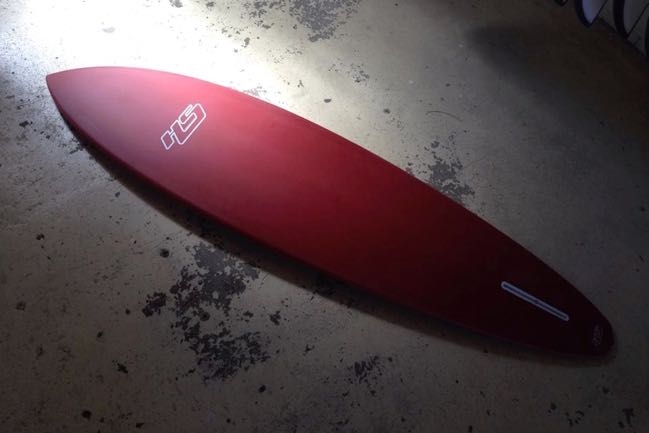Step Up Surfboards
What To Consider For Your Step Up Surfboard
We’ve covered a lot of different styles of boards in recent articles, including the advantages of riding an assortment of different boards in The Secret to Surfing Better, and how it can improve your overall surfing. So, now that your surfing is improving, you will start to feel the pull towards pushing yourself into bigger waves.
This is where your step ups start coming into play.
Just to be clear though, we are not talking about BIG waves, where you need a serious gun or even a semi gun. We are simply taking about those days where it is a little heavier or a little bigger than your average day and you just need a little extra board to get you into the waves a little easier while still being able to perform.

Asher Pacey putting his step up, the Sweet Spot 2.0 right where it wants to be.
You’re Not Chasing Rhino’s
A good Step Up surfboard will do just that. The proper step up doesn’t have to be that much bigger than what you normally surf. You would more or less be looking for something only a couple of inches longer than your go to and many times around the same width and thickness.
If anything, they could actually be a touch narrower as you don’t really need the volume to help you float.
The waves have more power behind them, so staying afloat on top of the wave is not the issue. What you need is something that will help you get into the wave easier or earlier, and a board that will help you manage a wave with more power.
Of course, just like any style of surfboard, a step up is somewhat relative. If you normally surf grovelers on smaller, mushy days, you step up might just be a standard high performance shortboard.
On the other hand, if you normally surf head high plus days, the step up for you might just be that semi gun for when it is double overhead or so. And we don’t necessarily have to be talking about high performance style thrusters either. There are plenty of single fin or even twin fin style of boards that can be considered your step up.
Consider The Waves
The type of step up you will need will also be dependent on the type of waves you are surfing. For example, if you are surfing a reef break or something a little more structured in how it breaks, you can generally get away with surfing something a little shorter, and maybe a touch thicker.
You still want that paddle power to help get you in early or take off under the lip, but you are not necessarily paddling around the line up searching for the waves. This allows you to surf a shorter board take the drop and have more maneuverability on the wave.

The Compression by Chemistry Surfboards will get you the waves you want on those days when your shorty can’t handle.
If you are surfing a heavy beach break, where you have to paddle around a lot, looking for waves and dealing with more elements, you probably want a board with a little more length that you can cover more ground on.
This will help you deal with the rips and all the water moving around throughout the line up. You may sacrifice a little bit of the maneuverability, but you won’t need that if you can’t get into any waves in the first place.
Basics Design Principles To Look For
There are a few tried and tested design principles that you should consider when choosing your step-up.
Most of which can be applied to various styles of boards. Since the wave has all the power needed to keep you up and floating, these characteristics are more for your ability to control the board and perform maneuvers instead of keeping you afloat and helping you make it through soft sections.
Tails
A pintail or rounded pintail is usually a safe bet when thinking about your next step up.
This type of tail will give you maximum hold and control from the back end of your board. Like we said above, the wave has all the power needed, so you don’t need a wide tail with extra surface area to keep you floating. You need something that will help grip into the face of the wave allowing you hold your rail in the water easier.

Different tail shapes will suit different conditions more than others.
Depending on the waves you will be surfing, try to aim for the rounded pin as that will allow you to surf the wave a little more. Remember, this is not a full on gun, so you will still want the maneuverability to rip the wave up, so the rounded pin as opposed to the straight up pintail will allow for this a little more.

The Wilderness by Album Surfboards is a prime example of an alternative step up, built for good waves!
Even if it is a twin fin fish style step up, the deep swallow tail essentially acts as a pintail for whichever rail is in the water, so by default, the fish already gives you that pintail hold you need for bigger surf.
Read more about how surfboard tails impact your performance.
Rocker Your Board Out
You can usually add a little more rocker to your board as well.
For the same reasons you can get away with a pintail, you can add more rocker. The wave has all the power needed, so having that flat/fast board for these waves is unnecessary. It could actually hurt they way you surf the wave as you may end up going too fast and have a difficult time wiping the speed off.

John John Florence needs every bit of performance out of his Step-Ups by Pyzel Surfboards.
Remember, you are not surfing massive waves here, you still want to have some performance, so there is no need to outrun the wave. Having more rocker will not only help stick late drops or re-entries off steep sections, it’ll loosen up the board allowing you to carve a little tighter when needed and fit in the pocket nicely.
Bottom Contours
The bottom contours of your board will play with how well you can get up to speed and on a plane, keeping your rail in the water, and the transition from rail to rail. The trusty single to double concave with a little vee out the tail goes a long way for your step up. This works extremely well for your thrusters and quads and shouldn’t have to be that much different than what your normal shorty has going on.

The Cannon by Haydenshapes Surfboards with some Vee entry to single concave to Vee out the tail, helping this low rockered single fin stick steep drops and roll from rail to rail with ease.
With a single fin or a step up fish, you might consider adding a bit more vee to help with the transition from rail to rail.
Also adding a bit of vee in the nose would certainly be handy since those boards generally have a little less rocker than a traditional thruster. That nose vee will help displace the water and keep it from pearling (nose diving) when taking late drops or coming out of turns on steeper sections.
Read our previous article for more info about surfboard bottom contours.
Beef It Up
This should go without saying, but we will say it anyways. Beef up the glassing on your step up.
If you have been reading our other articles, What to Know About Glassing a Surfboard, has given you the low down on the popular glassing schedules used.
A standard shortboard is normally glassed with two layers of 4 oz on the deck and one on the bottom (4+4×4). A fish or single fin, normally a little heavier like 4oz plus 6oz on the deck and either a 4 or 6 on the bottom (4+6×4, 4+6×6).
For your step up, you are going to want it glassed heavier. Something like 4+6×6 for a high performance style board and maybe 6+6×6 for a single fin or fish style. That extra glassing will go a long way for the life of your board especially if it is seeing heavier conditions.
Even simply paddling out on a heavy day can lead to your board being chopped in half if you get caught inside on a big close out. Beef it up and make sure it lasts.

Summary
There are so many options and variations for what you want to look for in a step up, but these general characteristics are fairly reliable.
Remember, you are not chasing massive surf with a board like this, so the general properties of your go to board should still apply, but with a touch more length or the alternative to help get you into waves earlier or manage your self around the line up.
If the wave is heavy and requires down the line speed, you can consider changing out your fins to a bigger, more upright fin for more drive and down the line control. Otherwise, you will still want maneuverability and performance, so sticking with the fins you usually surf is often a good idea.
At the end of the day, it all comes down to personal preference and what works for your style and ability.
Everyone is different and surfs in a unique way, so use these articles as a guideline, but figure out what really works for you and you will be a much better and therefore happier surfer overall.
Make sure you check out the Board Engine to find a range of boards all made in America by professional shapers at the top of their crafts. Email [email protected] with your details for a detailed report of board recommendations for you.






